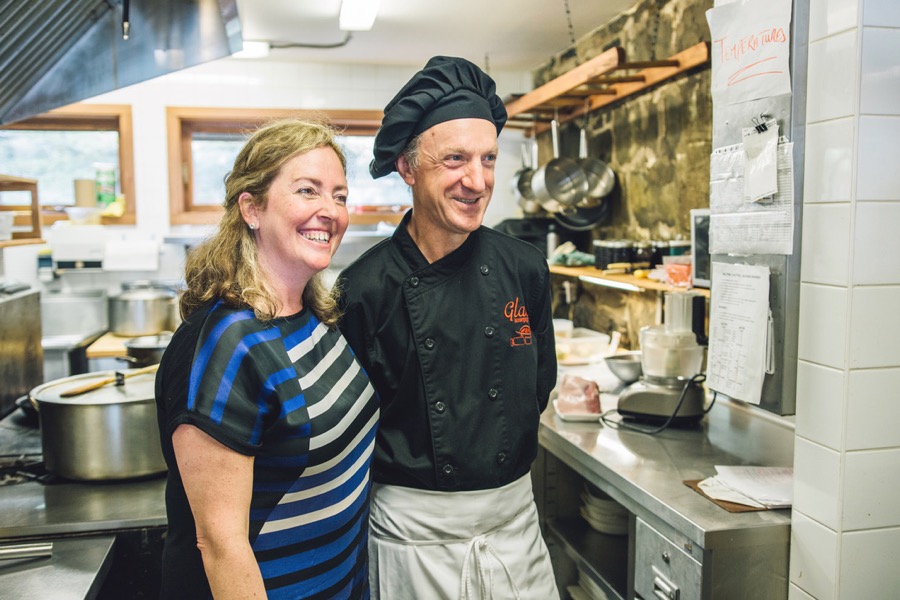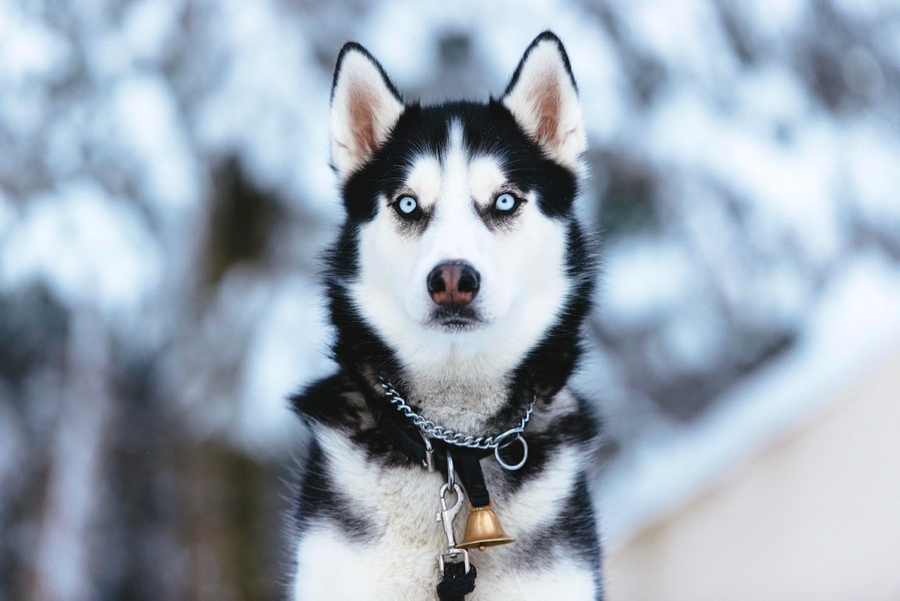Editor’s note: Toque & Canoe’s senior editor Valerie Berenyi, along with a handful of other travel writers, visited two lesser-known regions of La Belle Province known as Chaudière-Appalaches and Centre-du-Québec. Lucky for us, she returned with this post featuring highlights from a culturally rich adventure that included snow sports by day (cani-raquette anyone?) and legendary gastronomy by night. Enjoy!
Headlamps and haute cuisine
Located about an hour’s drive southeast from Quebec City, Auberge des Glacis is a small inn nestled in the bucolic Chaudière-Appalaches region. Dotted with pretty villages, the area borders the state of Maine and is wedged between the south shore of the St. Lawrence River and the Appalachian Mountains.
Former journalists Nancy Lemieux and André Anglehart purchased the inn — a charming stone building founded in 1841 as a flour mill — in 2006. The couple wanted a family project, one that would create a vibrant life for themselves and their two daughters, Audrey and Florence.
Turns out, running an isolated auberge in the forest can have its challenges. Three hours before dinner and a “100 per cent Quebecois” show, the lights flicker off. A tricky time for a power outage, I think, given that each of the inn’s 16 rooms and every seat in its restaurant is booked.
The innkeepers, on the other hand, take it in stride.
They calmly spring into action — lighting candles and pouring wine and shaking up cocktails du terroir, including the house signature Kir de Glacis: sparkling wine, maple syrup liqueur, cassis liqueur and iced apple cider garnished with maple sugar flakes and macerated cherries.
Kitchen staff, led by Chef Olivier Raffestin, don headlamps and continue preparations over propane stoves.
As we sit down to rillettes of salmon, the first of six gourmet courses, the power surges back on and a rollicking concert kicks off, which features none other than Lemieux, her daughters and several of their relatives.
Unflaggingly energetic and cheerful, they take turns singing, playing piano and strumming guitar between serving meals, opening wine and clearing plates.
These family shows happen only three or four times a year, so I feel lucky to catch one.
Given my lousy Western-Canadian high-school French, I can only smile, raise a toast to the friendly folks around me and feel envious of the rich traditions being shared in this warm, stone-walled room with a timbered ceiling and white lace curtains.
The diners, mostly friends and neighbours, sing along to favourites such as “Je Reviendrai à Montréal.” As I gaze at their beaming faces, it strikes me: this heritage and way of life is precious. No wonder the Quebecois guard their distinct society so fiercely.
I experienced a similar sentiment earlier in the day when I went snowshoeing on trails around the inn and climbed a hill to view the vast St. Lawrence in the distance.
Later, walking down a country lane to a nearby sugar bush where the maple sap was beginning to flow, the whole tableau seemed the stuff of storybooks, at once familiar and unfamiliar.

Owner Nancy Lemieux and Chef Olivier Raffestin of Auberge des Glacis / Photo by S. Allard courtesy Tourisme Chaudière-Appalaches
Lung-busting cani-raquette
With three downhill ski resorts and endless opportunities for cross-country skiing, snowshoeing, dogsledding and snowmobiling, the Appalachians are a paradise for winter-sport enthusiasts.
But cani-raquette? I’d never heard of the sport of snowshoeing with a dog.
After plates of poutine and a pint of Boréale Blanche at the main lodge of Appalaches resort, I literally hook up with Leila, a sweet, gentle husky. A wide belt goes around my hips with a bungee cord leash attached to the dog’s harness, and we are off!
On a wild romp through the forest, Leila powers me uphill and I clatter downhill as fast as I can to keep up with her. At one point, I accidentally step off the trail and plunge to the top of one thigh in the soft snow. Leila patiently stands beside me while I put a hand on her back and lever my buried leg out. Good girl. And we’re off, again!
A lung-busting session of cani-raquette is a good idea if a gut-busting maple meal at a sugar shack is to follow.
That night, I tuck into a family-style dinner at Le Bistreau d’érable, a “modern meets traditional” cabane a sucre in Parc des Appalaches, near Sugar Loaf Mountain.
The feast features all local foodstuffs — including pea soup, pork rinds, cretons (a type of pork pâté), sourdough bread, garden-fresh coleslaw, a beet and organic apple salad, meat pie with homemade fruit ketchup, an omelette served in a cast-iron skillet, baked beans, smoked ham with maple and sea buckthorn, pan-fried potatoes and crêpes with maple syrup.
The coup de grâce is maple jelly topped with house-made marshmallow and maple sugar crumbles. Unforgettable!
We roll away from the table to join Noémie Régnier, who owns Le Bistreau d’érable with her husband, Jerome Sauvageau, for a behind-the-scenes tour of a certified organic maple syrup operation.
Forget the old-school metal tap and bucket. Most maple producers today use smaller taps drilled into sugar maple trees that are connected by lines of tubing to the sugar shack. Trees are tapped for about two months, depending on when spring begins. This winter is unseasonably warm and the sap is flowing early.
Régnier shows us the clear maple “water” coursing from 25,000 surrounding trees into a huge reservoir tank before it’s reduced to syrup. Then she points to a wall of little bottles, each row documenting a year’s worth of products: clear syrup A is produced in cold weather and has a light, pure flavour, while B, C and D syrups, harvested later in the season, are darker and richer tasting. Every year is different.
Le Bistreau d’érable involves three generations of family, including Régnier’s school-age son, Phillipe, who takes great pride after the tour in pouring hot maple syrup on snow. We roll up the cooling taffy with popsicle sticks and let Mother Nature’s candy melt in our mouths.
I buy as many handmade products from their boutique as I can reasonably carry: bottles of amber syrup for gifts and a jar of exquisite maple-caramel coulis with fleur de sel for me. Later at home, I savour the coulis bit by tiny bit, comforted in knowing that I can purchase more online when I need a fix.

A cani-raquette husky at Appalaches resort / Photo courtesy Tourisme Chaudière-Appalaches
Marinating in maple butter
The early spring thaw means ice-skating on Lac William isn’t in the cards during my visit to Centre-du-Québec, a region located deep in the Appalachian foothills west of Chaudière-Appalaches.
Only an hour south of Quebéc City and about two hours from Montreal, Centre-du-Québec is a magnet for winter-loving families wanting to skate, ski, dogsled and snowmobile in the rolling countryside full of forests, sugar maples, lakes, villages and farms. (Summer revolves around boating, fishing, cycling, horseback riding and golf — and just imagine the brilliant leaves in fall!)
Instead of skating, I opt for a few hours of dog-free snowshoeing after checking into Manoir du Lac William, a family-oriented, hotel-resort hugging the shore of lovely Lake William near Saint-Ferdinand.
Requisite calories burned, I visit Spa détente du Lac William at the manoir for a truly regional experience.
A divine maple body treatment involves being exfoliated with maple sugar granules, coated in nourishing maple butter (naturally, the products are made in Quebec) and then swaddled in warm blankets to marinate.
The experience leaves my skin soft, silky and smelling sweetly of maple for days.
There are more pleasures to follow in the manoir’s dining room. The kitchen prides itself on using local products, and my entrée — a crispy and unctuous duck-leg confit served with shoestring potatoes and a red-wine demi-glace — is from the famous Canards du Lac Brome operation in Centre-du-Québec. A trio of sheep’s-milk cheeses for dessert hails from nearby Fromagerie La Moutonnière.
The following morning, feeling weak in the knees from the combination of snowshoeing, spa-ing and dining, I meet the manoir’s lively CEO for breakfast.
Franco Lessard says the property was originally built as a cottage in 1906 and became a hotel in 1956. When he, his sister and their father bought it in 1992, it was virtually unchanged from the ’50s. Over the past 25 years, it’s been transformed into a four-star operation with 55 rooms, two cottages and a condo, plus the spa, an indoor pool and series of outdoor thermal pools.
Manoir du Lac William is definitely a family affair. Lessard’s wife is the accounting manager and their 16-year-old daughter helps out in guest services with children’s after-dinner activities. (Family members start in the business at age 14.) One of Lessard’s sisters is the spa director. And a brother-in-law maintains the skating rink.
The operation is closed only one day a year. “Christmas,” says Lessard, “is for the family.”
Like other businesses I experience on this trip to La Belle Province, it seems that creating an opportunity for one’s family — and then working hard with joie de vivre to make it thrive — equals success in a region where it can be difficult to find a job.
When asked about her enviable situation at Auberge des Glacis with her husband and daughters, Nancy Lemieux responds with an irrepressible smile and says: “It’s a simple life.”
***Many thanks to our partners in tourism for supporting our writer’s trip to Quebec. This post was not reviewed or edited before publication. For other stories by Valerie Berenyi, check out Winter Joy in Jasper, Alberta, Wilderness City and Beyond, Puss’n (hiking) boots, Cold Land Warm Heart and Hotel Arts: The smart hipster’s sexy new hang-out.
Founded by two Canucks on the loose in a big country, Toque & Canoe is an award-winning Canadian travel blog.

